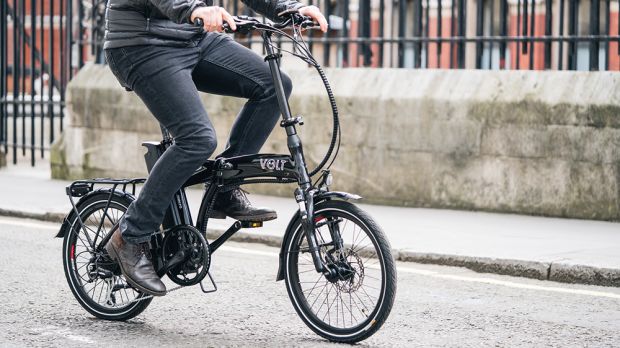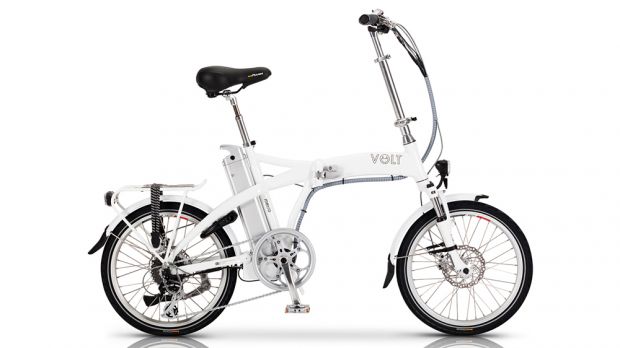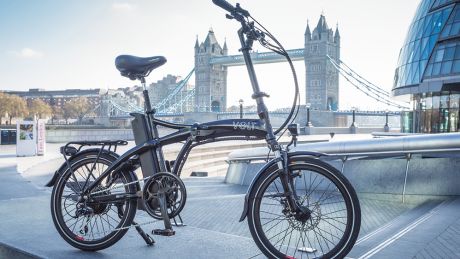You can trust Coach
Electric bikes are funny beasts. Folding bikes are also funny beasts. Logic dictates, then, that folding e-bikes are nothing short of hilarious – but there’s much to recommend in this 2017 model from Volt, a company that has been in the e-bike game since 2008.
A quick summary: it’s ideal for cycling busy roads in central London because of the extra control added by the thumb throttle; the fact it folds up means it can be tucked away more easily in my house at night; and the fat, spongy seat and fork suspension made for a smooth ride over the potholes that pockmark the streets of the capital.
Add to that the usual e-bike advantages of cycling uphill, or anywhere, without breaking a sweat and the relatively low price of £1,299 (relative for e-bikes) and it makes for a compelling package.
That’s only if you’re cool riding a folding bike, of course, which I’m not. But that’s down to a combination of regularly riding a hybrid on my 40-minute each-way commute and my gangly six-foot frame. Volt does say the Metro is for “the smaller rider”, and it has retail partners nationwide that have test models for you to try so you can find out if you fit Volt’s definition of “smaller”
I found the folding action unwieldy, although I admittedly have no experience in this area. The left pedal has to be aligned correctly (an easy detail to forget) before unclipping at the frame joint and folding it – an action I always struggled to do swiftly and competently. I assumed there’d be a clip to secure it in its folded form so it could be transported without swinging around, but no.
Still, I don’t think an e-bike is really suited to be taken on a train then unfolded for the final leg of a commute, as Volt suggests. At 21.3kg the Metro is on the light end of the e-bike weight spectrum, but it’s still on the heavy end of the things-we’re-able-to-carry-easily spectrum. If you’re stronger than me (and you probably are) then perhaps you’d have less trouble manoeuvring it on to a heaving commuter train, but if that’s what you’re intending to use it for I’d suggest you at least look into self-powered folding bikes which will be about half as heavy.
But before you discount a folding e-bike, consider where you’re storing your bike overnight. I keep mine indoors and it was bloody marvellous to be able to fold up the bike and tuck it away in a corner. If you can spare a cupboard, you could easily park the Metro in there.
If you’re locking it up outside, you’ll be pleased with the integrated lock. There’s a D-lock on the frame that locks the back wheel and an extra £30 will buy you a gold standard-rated chain which plugs into the same lock so it can be attached to a suitable fixed post.
It’s a really smart piece of design that saved me lugging heavy locks around in my backpack, although I could always have strapped a bag to the pannier rack. The battery is also locked into the frame so you don’t have to take it with you each time you park in a public area.

My commute along London’s cycle superhighway 7, and through busy areas like Parliament Square and Soho, nicely showed the advantages and limitations of the Metro. It really nailed the stop/start riding in central London thanks to the thumb throttle on the left handle.
The Volt rep who dropped the bike off explained that since these throttles now have to cut out after 3mph if you’re not pedalling, many brands have dropped them, but I found the manual control essential if you wanted to use the motor when pulling away from the lights in a pack. If you try to pull away slowly in a low gear or in automatic, a moment or two after you start pedalling the assist will kick in and a few times I found myself accelerating towards a cyclist who was slow to get going. I never rear-ended anyone (honest, officer), but I did have to brake quickly a couple of times.
The throttle means you can choose when the motor helps. Using it in this way did mean I often changed between the assist gears, and the buttons for this involved a thumb stretch. Not a massive problem by any means, but a better design would have been to make these buttons as accessible as the gear shifts on the right-hand handle.
So the throttle helps to pull away from a standing start quickly, which is great, unless you’re hitting a long straight, like a cycle superhighway, where the Metro suffers from its lack of top speed.
Here’s what happened to me over and over again. I pulled away and got in front of the pack; the motor cut out at 15.5mph; the combination of just eight gears and 20-inch wheels (OK, and a lack of effort) meant I was lucky to hit 20mph; everyone overtook me – until I caught up with them at the next red light. And the whole thing repeated again.

This bike isn’t meant for speed and distance, but it also means on those nights when you leave a little late and want to put the effort in on your ride home to make up the time, you’ll be stymied. That’s not to say my commute took much longer – it was pretty comparable to riding on a self-powered bike.
Volt claims that the battery can take you over 50 miles (depending on the level of assistance) which seems a very robust claim to me after testing. I did 51.1 miles over four-and-a-half hours on one charge, and I rinsed the throttle at every opportunity and used the automatic gear to get the max amount of assistance possible (what is the point of an e-bike otherwise?).
If you’re just looking for a little assistance when pulling away (gears one and two), you’ll go a lot further on a charge. In case you’re worried the lights will drain the battery in the darker months, rest assured that the built-in front and rear LED lights run on their own batteries. And, as promised, the battery charged back up to full after three and a half hour.
If you live in or around a city centre in a small abode, and are looking for an easy, mildly active way into work you’d be well served to take the Volt Metro for a spin – especially if you have to tackle hills to get to and from your job.
£1,299, buy the Metro Commuter E-Bike on voltbikes.co.uk
RECOMMENDED: Ridgeback E-Flight Di2 Electric Bike Review – The E-Bike That Rides Like A Regular Bike

Jonathan Shannon was the editor of the Coach website from 2016 to 2024, developing a wide-ranging experience of health and fitness. Jonathan took up running while editing Coach and used the training plans on the site to run a sub-40min 10K, 1hr 28min half marathon and 3hr 6min marathon. He’s an advocate of cycling to work and is Coach’s e-bike reviewer, and not just because he lives up a bit of a hill. He also reviews fitness trackers and other workout gear.

